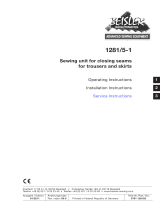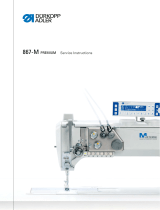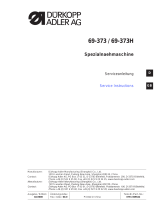Page is loading ...

667
Service Instructions

All rights reserved.
Property of Dürkopp Adler AG and protected by copyright. Any reuse of these contents, including
extracts, is prohibited without the prior written approval of Dürkopp Adler AG.
Copyright © Dürkopp Adler AG 2016
IMPORTANT
READ CAREFULLY BEFORE USE
KEEP FOR FUTURE REFERENCE

Table of Contents
Service Instructions 667 - 00.0 - 04/2016 1
1 About these service instructions..............................................3
1.1 Scope of the service instructions..................................................3
1.2 Representation conventions – symbols and characters...............3
1.3 Other documents..........................................................................4
1.4 Liability..........................................................................................4
2 Safety...........................................................................................5
2.1 Basic safety instructions...............................................................5
2.2 Signal words and symbols used in warnings................................6
3 Working basis............................................................................. 9
3.1 Order of the settings.....................................................................9
3.2 Cable routing................................................................................9
3.3 Removing the covers..................................................................10
3.3.1 Tilting and erecting the machine head........................................10
3.3.2 Removing and placing the arm cover.........................................11
3.3.3 Removing and placing the head cover.......................................12
3.3.4 Removing and placing the valve cover.......................................13
3.3.5 Removing and installing the throat plate ....................................14
3.3.6 Removing and installing the feed dog ........................................15
3.4 Flats on shafts ............................................................................16
3.5 Locking the sewing machine in place.........................................16
3.6 Setting the handwheel into position............................................18
4 Positioning the arm shaft.........................................................19
5 Setting the handwheel scale ...................................................21
6 Positioning the toothed belt wheels.......................................23
6.1 Setting the upper toothed belt wheel..........................................23
6.2 Setting the lower toothed belt wheel...........................................25
7 Setting the stitch length adjusting wheels.............................27
7.1 Setting the upper stitch length adjusting wheel..........................28
7.2 Setting the lower stitch length adjusting wheel...........................30
7.3 Setting the stitch length limit.......................................................32
7.4 Setting the eccentric for the forward and backward stitches......33
8 Setting the feed dog.................................................................35
8.1 Setting the feed dog position......................................................35
8.1.1 Moving the feed dog...................................................................36
8.1.2 Moving the feed dog carrier........................................................37
8.2 Setting the feed dog movement..................................................38
8.2.1 Setting the feed movement.........................................................38
8.2.2 Setting the feed dog height at top dead center...........................39
8.2.3 Setting the stroke movement......................................................40
9 Aligning the needle bar linkage...............................................43
9.1 Moving the needle bar linkage sideways....................................43
9.2 Aligning the needle bar linkage in the sewing direction..............45
10 Position of the hook and needle .............................................47
10.1 Setting the hook side clearance .................................................47

Table of Contents
2 Service Instructions 667 - 00.0 - 04/2016
10.2 Setting the loop stroke position ..................................................49
10.3 Setting the needle bar height......................................................51
11 Sewing feet................................................................................53
11.1 Setting an even sewing foot stroke.............................................54
11.2 Setting the stroke movement for the feeding foot.......................55
11.3 Setting the sewing foot pressure................................................57
11.4 Setting the sewing foot lifting height...........................................58
12 Setting the needle thread tension...........................................59
12.1 Setting the needle thread regulator ............................................59
12.2 Setting the thread tensioning spring...........................................60
13 Winder .......................................................................................61
13.1 Setting the winder.......................................................................61
13.2 Setting the hook thread guide.....................................................64
14 Thread cutter.............................................................................65
14.1 Setting the control cam position .................................................65
14.2 Setting the armature of the thread cutter magnet.......................66
14.3 Setting the position of the thread-pulling knife............................67
14.4 Setting the cutting pressure........................................................68
15 Setting the potentiometer........................................................71
16 Maintenance..............................................................................73
16.1 Cleaning .....................................................................................74
16.1.1 Cleaning the machine.................................................................74
16.1.2 Cleaning the motor fan mesh .....................................................75
16.2 Lubricating..................................................................................76
16.2.1 Lubricating the machine head ....................................................77
16.2.2 Lubricating the hook...................................................................78
16.3 Servicing the pneumatic system.................................................79
16.3.1 Setting the operating pressure ...................................................79
16.3.2 Draining the water condensation................................................80
16.3.3 Cleaning the filter element..........................................................81
16.4 Servicing specific components...................................................82
16.5 Parts list......................................................................................82
17 Decommissioning.....................................................................83
18 Disposal.....................................................................................85
19 Technical data........................................................................... 87

About these service instructions
Service Instructions 667 - 00.0 - 04/2016 3
1 About these service instructions
These instructions for sewing machine 667 was compiled with the utmost
care. They contain information and notes intended to ensure long-term
and reliable operation.
1.1 Scope of the service instructions
The instructions describe the setting and maintenance work on the 967
sewing machine. They apply to all subclasses.
The proper use and setup is described in the Operating Instructions.
1.2 Representation conventions – symbols and characters
Various information in these instructions is represented or highlighted by the
following characters in order to facilitate easy and quick understanding:
Proper setting
Specifies proper setting.
Disturbances
Specifies the disturbances that can occur from an incorrect setting.
Steps to be performed when operating the machine (sewing and
equipping)
Steps to be performed for service, maintenance, and installation
Steps to be performed via the software control panel
The individual steps are numbered:
1. First step
2. Second step
The steps must always be followed in the specified order.
Lists are marked by bullet points.
Result of performing an operation
Change to the machine or on the display.
Important
Special attention must be paid to this point when performing a step.
1.
2.
•

About these service instructions
4 Service Instructions 667 - 00.0 - 04/2016
Information
Additional information, e.g. on alternative operating options.
Order
Specifies the work to be performed before or after a setting.
References
Reference to another section in these instructions.
Safety Important warnings for the user of the machine are specifically marked.
Since safety is of particular importance, hazard symbols, levels of danger
and their signal words are described separately in 2 Safety.
Location
information
If no other clear location information is used in a figure, indications of right
or left are always from the user's point of view.
1.3 Other documents
The device contains built-in components from other manufacturers.
Each manufacturer has performed a hazard assessment for these
purchased parts and confirmed their design compliance with applicable
European and national regulations. The proper use of the built-in compo-
nents is described in the corresponding manufacturer's instructions.
1.4 Liability
All information in these service instructions was compiled in accordance
with the current state of the art and the applicable standards and
regulations.
The manufacturer cannot be held liable for damages resulting from:
• Breakage and damage during transport
• Failure to follow the operating instructions
• Improper use
• Unauthorized modifications to the machine
• Use of untrained personnel
• Use of unapproved parts

Safety
Service Instructions 667 - 00.0 - 04/2016 5
2 Safety
This chapter contains basic information for your safety. Read the instruc-
tions carefully before setting up or operating the machine. Make sure to
follow the information included in the safety instructions. Failure to do so
can result in serious injury and property damage.
2.1 Basic safety instructions
The machine may only be used as described in these instructions.
The instructions should be available at the machine's location at all times.
Work on live components and equipment is prohibited. Exceptions are de-
fined in the DIN VDE 0105.
For the following work, the machine must be disconnected from the power
supply using the main switch or by disconnecting the power plug:
• Replacing the needle or other sewing tools
• Leaving the workstation
• Performing maintenance work and repairs
• Threading
Missing or faulty parts could impair safety and damage the machine.
Therefore only use original parts from the manufacturer.
Transport Use a lifting carriage or forklift to transport the machine. Raise the machine
max. 20 mm and secure it to prevent it from slipping off.
Setup The connecting cable must have a power plug approved in the relevant
country. The power plug may only be connected to the power cable by
qualified specialists.
Obligations
of the operator
Follow the country-specific safety and accident prevention regulations and
the legal regulations concerning industrial safety and the protection of the
environment.
All the warnings and safety signs on the machine must always be in legible
condition, and must not be removed. Missing or damaged labels must be
replaced immediately.
Requirements
to be met by
the personnel
The machine may only be set up by qualified specialists.
Maintenance work and repairs may only be carried out by qualified
specialists.
Work on electrical equipment may only be carried out by qualified specialists.
Only authorized persons may work on the machine. Every person who
works on the machine must first have understood these instructions.

Safety
6 Service Instructions 667 - 00.0 - 04/2016
Operation Inspect the machine for any externally visible damage during use.
Stop working if you notice any changes to the machine. Report any changes
to your supervisor. Machines must no longer be used if they are damaged.
Safety
equipment
Safety equipment should not be removed or deactivated. If it is essential
to remove or deactivate safety equipment for a repair operation, it must be
refitted and put back into service immediately afterward.
2.2 Signal words and symbols used in warnings
Warnings in the text are distinguished by color bars. The color scheme
based on the severity of the danger. Signal words indicate the severity of
the danger.
Signal words Signal words and the hazard they describe:
Symbols The following symbols indicate the type of danger to personnel:
Signal word Meaning
DANGER (with hazard symbol)
If ignored, fatal or serious injury will result
WARNING (with hazard symbol)
If ignored, fatal or serious injury can result
CAUTION (with hazard symbol)
If ignored, moderate or minor injury can result
NOTICE (without hazard symbol)
If ignored, property damage can result
Symbol Type of danger
General
Electric shock

Safety
Service Instructions 667 - 00.0 - 04/2016 7
Examples Examples of the layout of warnings in the text:
This is what a warning looks like for a hazard that will result in serious
injury or even death if ignored.
This is what a warning looks like for a hazard that could result in seri-
ous or even fatal injury if ignored.
This is what a warning looks like for a hazard that could result in
moderate or minor injury if the warning is ignored.
Sharp parts
Crushing
Environmental damage
Symbol Type of danger
DANGER
Type and source of danger!
Consequences of non-compliance.
Measures for avoiding the danger.
WARNING
Type and source of danger!
Consequences of non-compliance.
Measures for avoiding the danger.
CAUTION
Type and source of danger!
Consequences of non-compliance.
Measures for avoiding the danger.

Safety
8 Service Instructions 667 - 00.0 - 04/2016
This is what a warning looks like for a hazard that could result in envi-
ronmental damage if ignored.
This is what a warning looks like for a hazard that could result in
property damage if ignored.
CAUTION
Type and source of danger!
Consequences of non-compliance.
Measures for avoiding the danger.
NOTICE
Type and source of danger!
Consequences of non-compliance.
Measures for avoiding the danger.

Working basis
Service Instructions 667 - 00.0 - 04/2016 9
3 Working basis
3.1 Order of the settings
The setting positions for the sewing machine are interdependent.
Always comply with the order of individual setting steps as specified.
It is absolutely essential that you follow all notices regarding prerequisites
and subsequent settings that are marked with in the margin.
3.2 Cable routing
Ensure that all cables are laid in the machine such that the function of
moving parts is not hampered.
1. Lay any excess cabling neatly in proper cable snakes.
2. Bind together the cable loops with cable ties.
Tie loops wherever possible to fixed parts.
The cables must be secured firmly.
3. Cut off the extending ends of cable ties.
NOTICE
Property damage may occur!
Risk of machine damage from incorrect order.
It is essential to follow the working order specified in these instructions.
NOTICE
Property damage may occur!
Machine damage and malfunctions can be caused by laying the
cables incorrectly.
Lay excess cabling in such a way that moving parts are not impaired
in their ability to function correctly.

Working basis
10 Service Instructions 667 - 00.0 - 04/2016
3.3 Removing the covers
For many types of setting work, you will have to remove the machine cov-
ers first in order to access the components.
This chapter describes how to remove and then refit the individual covers.
The text for each type of setting work then specifies only the cover that
needs to be removed at that particular time.
3.3.1 Tilting and erecting the machine head
To access the components on the underside of the machine, swivel up the
machine head.
Fig. 1: Tilting and erecting the machine head
Tilting the machine head
To tilt the machine head:
1. Tilt the machine head as far as it will go.
Erecting the machine head
To erect the machine head:
1. Erect the machine head.
WARNING
Risk of injury from moving parts!
Crushing possible.
Switch off the machine before removing or
re-placing covers.

Working basis
Service Instructions 667 - 00.0 - 04/2016 11
3.3.2 Removing and placing the arm cover
Fig. 2: Removing and placing the arm cover
Removing the arm cover
To remove the arm cover:
1. Position the left adjusting wheel for the sewing foot stroke (2) to 2.
2. Loosen the screws (1).
3. Hold the arm cover (3) at the adjusting wheels and remove it.
Placing the arm cover
To place the arm cover:
1. Position the left adjusting wheel for the sewing foot stroke (2) to 2.
2. Place the arm cover (3).
3. Tighten the screws (1).
(1) - Screws
(2) - Left adjusting wheel for sewing
foot stroke
(3) - Arm cover
②
③
①

Working basis
12 Service Instructions 667 - 00.0 - 04/2016
3.3.3 Removing and placing the head cover
Fig. 3: Removing and placing the head cover
Removing the head cover
To remove the head cover:
1. Loosen the screws (1).
2. Remove the head cover (2).
Placing the head cover
To place the head cover:
1. Place the head cover (2).
2. Tighten the screws (1).
(1) - Screws (2) - Head cover
②
①

Working basis
Service Instructions 667 - 00.0 - 04/2016 13
3.3.4 Removing and placing the valve cover
Fig. 4: Removing and placing the valve cover
Removing the valve cover
To remove the valve cover:
1. Loosen all 4 screws (1).
2. Remove the valve cover (2).
Important
When removing the valve cover, be sure not to pull off any cables.
Placing the valve cover
To place the valve cover:
1. Place the valve cover (2).
2. Tighten all 4 screws (1).
Important
When placing the valve cover, be sure not to pull off any cables.
(1) - Screws (2) - Valve cover
②
①

Working basis
14 Service Instructions 667 - 00.0 - 04/2016
3.3.5 Removing and installing the throat plate
Fig. 5: Removing and installing the throat plate
Removing the throat plate
To remove the throat plate:
1. Loosen the screws (1).
2. Remove the throat plate (2).
Installing the throat plate
To install the throat plate:
1. Insert the throat plate (2).
2. Tighten the screws (1).
WARNING
Risk of injury from sharp and moving parts!
Crushing and puncture possible.
Switch off the machine before you remove or install
the throat plate.
(1) - Screws (2) - Throat plate
①
②

Working basis
Service Instructions 667 - 00.0 - 04/2016 15
3.3.6 Removing and installing the feed dog
Fig. 6: Removing and installing the feed dog
Removing the feed dog
To remove the feed dog:
1. Tilt the machine head.
2. Loosen the screws (3).
3. Take the feed dog (1) off the feed dog carrier (2).
Installing the feed dog
To install the feed dog:
1. Place the feed dog (1) onto the feed dog carrier (2).
2. Tighten the screws (3).
Important
Check the feed dog position in its movement at maximum stitch length
(depending on the equipment: 6, 9 or 12) by turning the handwheel.
The feed dog must not hit against the throat plate.
Order
Then check the following setting:
• Feed dog ( p. 36)
WARNING
Risk of injury from sharp and moving parts!
Crushing and puncture possible.
Switch off the machine before you remove or install
the feed dog.
(1) - Feed dog (2) - Feed dog carrier
(3) - Screws
①
②
③

Working basis
16 Service Instructions 667 - 00.0 - 04/2016
3.4 Flats on shafts
Fig. 7: Flats on shafts
Some shafts have flat surfaces at the points where the components are
screwed on. This stabilizes the connection and makes adjustment easier.
Important
Always ensure that the screws are completely flush with the surface.
3.5 Locking the sewing machine in place
For some settings, the machine must be locked in place. To do this, the
arresting pin from the accessory pack is inserted into a slot on the arm
shaft crank, blocking the arm shaft.
Fig. 8: Locking the sewing machine in place (1)
2
1
(1) - Flat (2) - Shaft
(1) - Arresting pin
(2) - Large arresting groove
(3) - Small arresting groove
(4) - Arm shaft crank
①
②
③
5 mm
3 mm
④

Working basis
Service Instructions 667 - 00.0 - 04/2016 17
There are 2 securing positions:
• Position 1: Loop stroke position
• 5 mm end in the large slot
• Setting the loop stroke and needle bar height
• Position 2: Handwheel zero position
• 3 mm end in the small slot
• Setting the handwheel position and checking the top dead center
for the needle bar
Fig. 9: Locking the sewing machine in place (2)
Locking the machine in place
1. Remove the plug from the locking slot (2).
2. Turn the handwheel until the appropriate groove (1) is in front of the
locking opening (2):
• Small slot at handwheel position 0°
• Large groove at handwheel position 200 – 205°
3. Insert the arresting pin (3) with the appropriate end in the groove (1).
Removing the positional lock
1. Pull the arresting pin (3) out of the groove (1).
2. Insert the plug into the locking opening (2).
(1) - Slot
(2) - Locking opening
(3) - Arresting pin
①
②
③

Working basis
18 Service Instructions 667 - 00.0 - 04/2016
3.6 Setting the handwheel into position
For some settings, the graduated scale on the handwheel has to be moved
to a certain position.
Fig. 10: Setting the handwheel into position
To set the handwheel into position:
1. Turn the handwheel until the specified number on the graduated
scale (1) is next to the marking (2).
(1) - Graduated
scale
(2) - Marking
①
②
/







